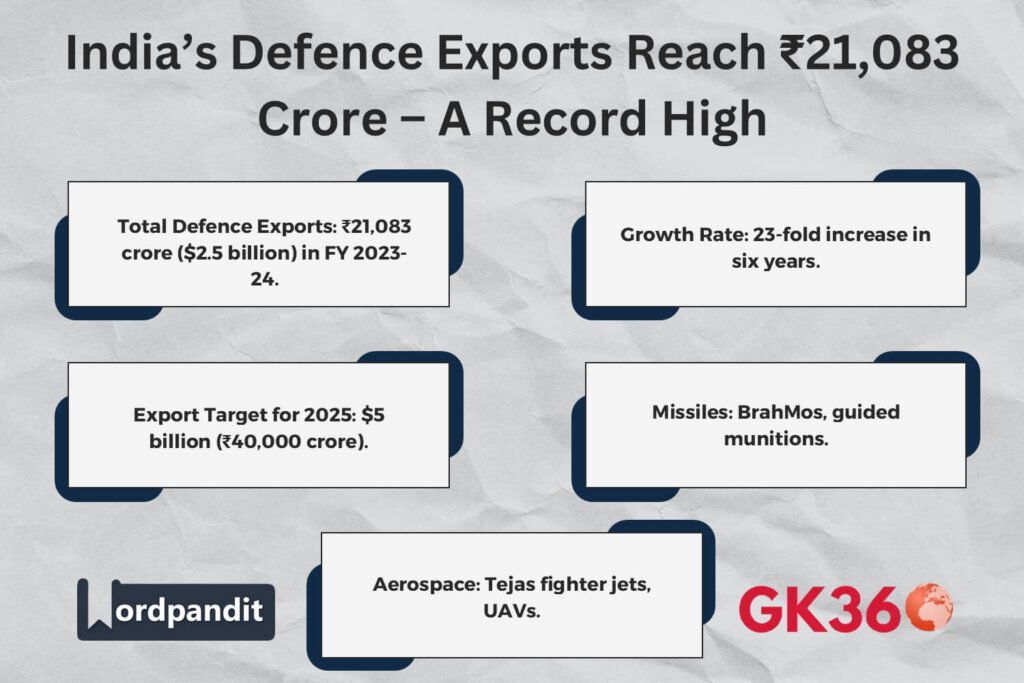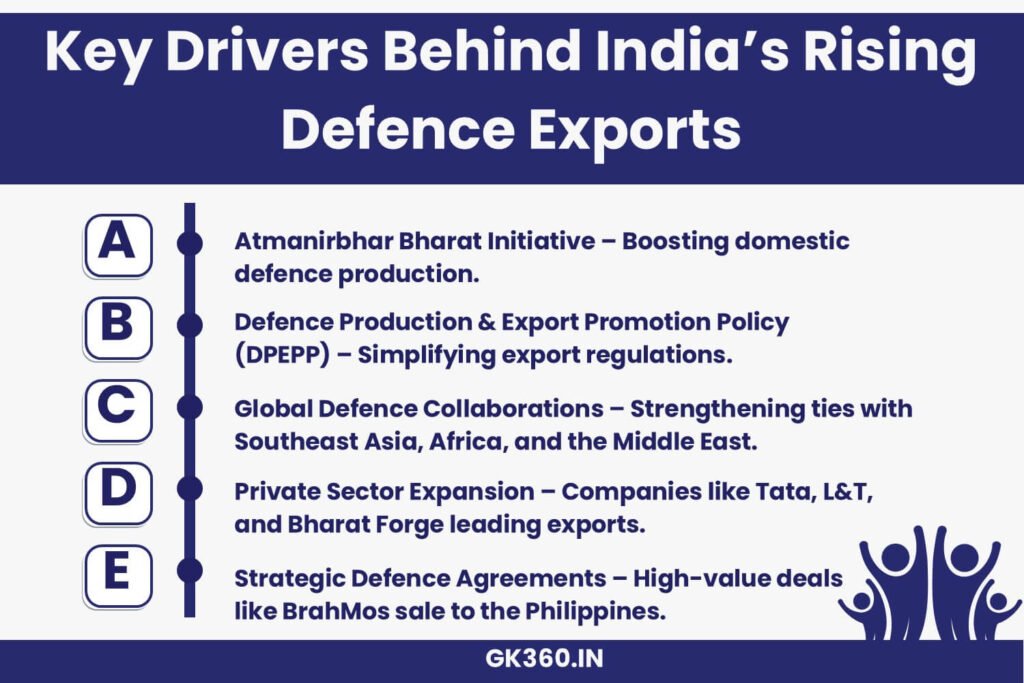India’s Defence Exports Soar to ₹21,083 Crore in 2023-24: Growth Drivers & Global Impact
Introduction
India has achieved a remarkable milestone in its defence sector, recording all-time high defence exports worth ₹21,083 crore for the financial year 2023-24. This achievement underscores India’s growing self-reliance in defence manufacturing and its ambitions to emerge as a global hub for military production. Driven by policy reforms, technological advancements, and increasing global demand for indigenous defence products, this growth sets the stage for India’s ambitious $5 billion (approximately ₹40,000 crore) export target by 2025.

Table of Contents
- India’s Record Defence Exports in 2023-24: A Milestone
- Key Growth Drivers Behind the Success
- India’s Defence Export Portfolio: Key Products & Markets
- Global Outreach: Top Countries Buying Indian Defence Equipment
- Challenges in Expanding Defence Exports
- Future Prospects: India’s $5 Billion Target by 2025
- FAQs on India’s Defence Exports
- Conclusion: India’s Path to Becoming a Defence Export Hub
1. India’s Record Defence Exports in 2023-24: A Milestone
The Ministry of Defence announced that India’s defence exports in FY 2023-24 had reached an unprecedented ₹21,083 crore, marking a 23-fold growth in the past six years. This record-breaking figure highlights India’s increasing footprint in the global arms trade and showcases its evolving capabilities in military manufacturing.
2. Key Growth Drivers Behind the Success
Several key factors have contributed to this historic rise in India’s defence exports:
Government Policy Reforms
- Introduction of the Defence Production and Export Promotion Policy (DPEPP) to streamline export procedures.
- Fast-track approvals for defence product exports.
- Promotion of the ‘Make in India’ initiative to boost domestic defence manufacturing.
Impact of Atmanirbhar Bharat in Defence
- Emphasis on indigenous production has reduced reliance on foreign imports.
- Expansion of public-private partnerships in the defence sector.
Strategic Global Collaborations
- Strengthened defence ties with Southeast Asia, the Middle East, and Africa.
- Landmark deals, such as the BrahMos missile export to the Philippines.
Private Sector’s Expanding Role
- Companies like Bharat Forge, Tata Advanced Systems, and L&T Defence are playing a crucial role in ramping up production.
Government Support & Incentives
- Tax benefits and funding support for defence R&D.
- Increased participation in international defence expos to showcase India’s capabilities.
3. India’s Defence Export Portfolio: Key Products & Markets
India’s defence products have gained significant global traction, with a diverse range of high-quality products exported to various countries. Some key products include:
- Aerospace: Tejas light combat aircraft, advanced drones, avionics.
- Naval Systems: Patrol vessels, maritime surveillance systems.
- Land Systems: Armoured vehicles, artillery guns, small arms.
- Missiles & Munitions: BrahMos supersonic cruise missiles, guided munitions.
4. Global Outreach: Top Countries Buying Indian Defence Equipment
India’s defence products have gained traction in over 85 countries, with top buyers including:
- Philippines: BrahMos missile deal.
- Vietnam: Naval systems, surveillance equipment.
- Armenia: Artillery, radar systems.
- Middle Eastern & African nations: Armoured vehicles, small arms.
5. Challenges in Expanding Defence Exports
Despite the rapid growth, India faces several challenges in sustaining and expanding its defence exports:
- Global Competition: Competing with established exporters like the USA, Russia, and China.
- Technology Gaps: Need to enhance high-end defence technology development.
- Geopolitical Risks: Exporting to politically unstable regions poses risks.
- Infrastructure & Investment: Scaling up manufacturing and boosting R&D investments is crucial.
6. Future Prospects: India’s $5 Billion Target by 2025
India aims to achieve $5 billion in defence exports by 2025 through:
- Strengthening global defence partnerships.
- Promoting defence startups & innovation.
- Expanding defence industrial corridors in Uttar Pradesh and Tamil Nadu.
- Integrating AI, robotics, and next-gen defence technologies.
7. FAQs on India’s Defence Exports
- What are India’s top defence exports?
India exports aircraft, missiles, artillery, drones, and naval vessels to various global markets. - Which countries buy Indian defence equipment?
Nations such as the Philippines, Vietnam, Armenia, and several African and Middle Eastern countries have emerged as key buyers. - How has Atmanirbhar Bharat contributed to defence exports?
The initiative has strengthened domestic manufacturing, reduced import dependence, and increased India’s capability to export advanced defence products. - What is India’s defence export target for 2025?
India is targeting $5 billion (₹40,000 crore) in defence exports by 2025. - How does India compare to other global defence exporters?
India is an emerging player but faces stiff competition from the USA, Russia, and China. However, its cost-effective and high-quality products are gaining traction globally.
8. Conclusion: India’s Path to Becoming a Defence Export Hub
India’s record ₹21,083 crore in defence exports signals its rise as a major player in the global arms market. By addressing challenges and leveraging opportunities, India is well on its way to achieving its $5 billion export target by 2025. With a strong policy framework, robust private sector involvement, and growing international collaborations, India is set to become a global hub for defence manufacturing and exports.
Key Takeaways Table
| Aspect | Details |
|---|---|
| Total Defence Exports (FY24) | ₹21,083 crore ($2.5 billion) |
| Export Growth | 23x increase in six years |
| Top Exported Products | Missiles, aircraft, naval & land systems |
| Leading Importing Nations | Philippines, Vietnam, Armenia, Middle East, Africa |
| Government Strategy | DPEPP 2020, Atmanirbhar Bharat, defence industrial corridors |
| Export Target for 2025 | $5 billion (₹40,000 crore) |
SEO-Driven Tags
- India defence exports 2023-24
- India’s ₹21,083 crore military exports
- India’s top defence exports and buyers
- Make in India defence manufacturing
- BrahMos missile export deal 2024
- India’s $5 billion defence export target 2025
- Indian defence industry global partnerships
- Atmanirbhar Bharat in defence sector
- India defence exports vs China and Russia
- Future of India’s defence manufacturing






